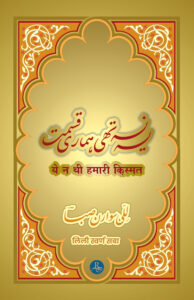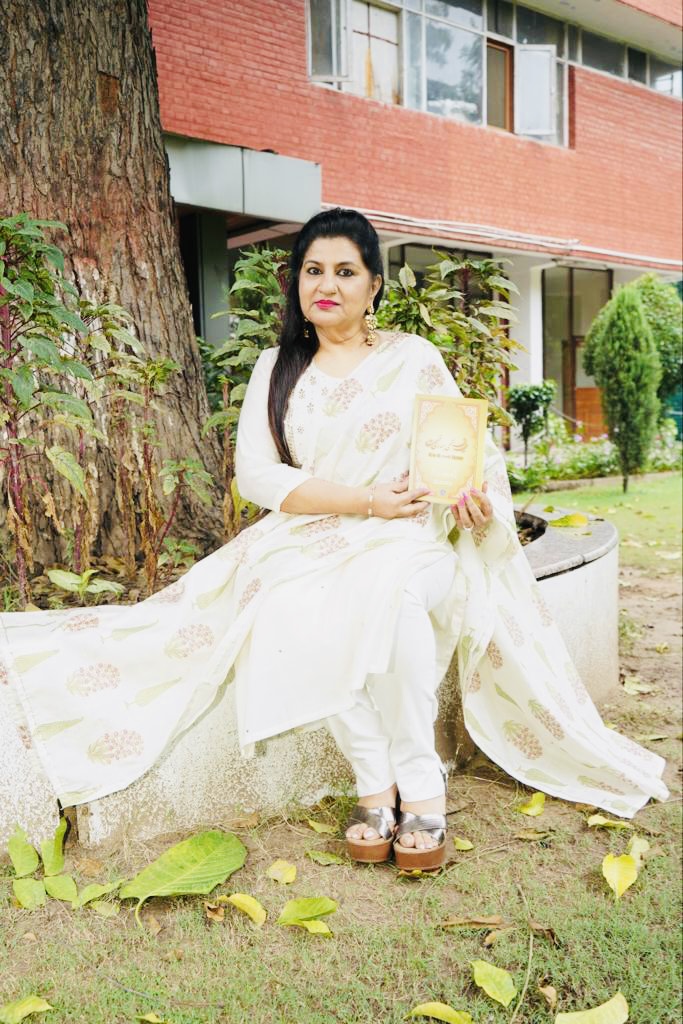Lily Swarn, the award-winning poet and author released her collection of Urdu ghazals at the Press Club of Chandigarh amid fanfare and wide media coverage. In this conversation with Kashmir Newsline, she talks about the book and how she fell in love with Urdu language.
Yeh Na Thi Hamari Qismat is an evocative title. How did it come about?
The strains of Ghalib’s immortal ghazal, ye na thi hamari qismat ke visal-e-yaar hota, have haunted me ever since I first heard it crooned on a Murphy radio tucked in a wooden niche in my distant youth and that is where the title of my book comes from. The book is a collection of Urdu ghazals written over the last three and a half years. It is bilingual with Hindi script on the opposite page. Books are never planned. They force their way into this world with defiance, amply aided by mystical destiny. There are over 80 ghazals. Many are romantic, some reflecting the present times, others describing alienation during the pandemic. They speak of ego wars, desperation in the face of separation. I think the most potent of all emotions in this collection is the ehsaas of hijr -yearning for a heartless beloved.
What motivated you to choose Urdu as a medium? After all, you haven’t formally studied Urdu.
Urdu is the language in which you can express myriad facets of love and ghazals are inherently couplets entwined on a pearly string of love. Knowing a different language shows one a different vision of life. We can easily phrase and rephrase our sentences in Urdu and use the one which fits the situation. A word in Urdu has many synonyms, meanings and uses as well as different communicative effects. It was known to be the language of the educated, the nobility, but while living in Lucknow for a few years, I heard even a humble rickshaw puller speak in chaste Urdu. I grew up in a Punjabi speaking Sikh household where the language was generously peppered with English and abundantly laced with Urdu words. My dad had schooled across the border in Sargodha till matriculation therefore he had tremendous command over both spoken and written Urdu. I was learning the poetry of revered masters of Urdu shayari without even realising it. Iqbal, Mir , Daagh , Ghalib, Zauq just rolled off his tongue with perfect pronunciation and modulation. The mesmerising intonation of sounds was hypnotic to my impressionable mind. Soon he tutored me to pronounce ghazal with an epiglottal effect. The training started young. This book is my humble tribute to the queen of the romantic languages. It shouldn’t be allowed to get frail. Many children raised in Urdu speaking households can’t converse effectively in the language, let alone write it. I firmly believe that languages have no religion. They are large-hearted, ever willing to assimilate and imbibe fresh vocabulary.
Were there other influences in your life that steered this passion for ghazal writing?
A chance encounter can certainly manoeuvre our thoughts. It was a haseen ittefaaq – beautiful coincidence – to meet and interview the awe-inspiring Faiz Ahmed Faiz during my days as student editor of my college magazine. As he recited his verses, I remember recording them in my rickety cassette player and gazing goggle-eyed. He recited:
tere honton ke phoolon ki chahat meen hum
daar ki khushk tehni pe vaare gaye
I think that’s when I knew that I would surely be writing in this lyrical language.
In the foreword of this book, renowned Kashmiri litterateur, Prof Muhammad Zaman Azurdah, mentions that most Bollywood songs have Urdu words but are known as Hindi songs. No wonder I love listening to Mohammad Rafi songs. It is not just his voice that seduces but the magic of the Urdu lyrics as well. I am humbled that Zaman sahab feels that my ghazals have “the sweetness of Punjab, the relief that comes from the breeze of Himachal and the smoothness of Urdu.” Qawaalis have also stirred me both for their form and the lyrics chosen. Sufi poets like Shah Hussain for his kaafis, Bulle Shah, Farid also influenced my thoughts as did Faraz and Parveen Shakir.

(Ye Na Thi Hamari Qismat, an anthology of ghazals, is Lily Swarn’s first book in Urdu.)
What were your feelings when you read the review of your poetry by Rekhta’s Prof Anisur Rehman?
It was a pat on the back for my labour of love for the language that my forefathers might have conversed in. These words for a fledgling Urdu poet are indeed encouraging: “Lily Swarn is a poet of intense emotions and expressions. She draws liberally upon various facets of life and longing, of pain and pining, and of hope and faith.”
Some of your ghazals from Ye Na Thi Hamari Qismat have already been put to music?
It makes me truly happy that seven or eight of my ghazals have already been sung by mellifluous voices. Samina Aslam produced and Saleem Ahmed sang oas ki boond roti rahi raat bhar. It has an exquisite video also. Musafir has lent his deep and soulful notes to seven ghazals including the highly popular rukh pe woh mahtaab rakhte hain. I am happy to share with you that when I had just started penning ghazals in 2019, Ustad Qaiser Nizami of Kashmir too hummed a few couplets of mine on my request. Recently Sunaini Sharma, the talented granddaughter of the Koel of Punjab, Surinder Kaur, composed and sang kuchh na kuchh baat hoti rehti hai.
Writing ghazals is a tough act to follow. Isn’t it?
That is where destiny knocked on my door insistently and loudly. I was writing Urdu nazms since long. Sometimes a couplet or two would also take shape by a favourable stroke of luck. One day I got a call from a Sufi scholar, Syed Zia Alvi .He suggested I start penning ghazals as I had enough words in my quiver. He had read my nazms on social media. I told him that I had no knowledge of metre, merely an instinctive rhythm that is unborn in most humans. Besides, I was terrified of counting, being atrocious at numbers. Alvi sahab told me to hum the misra – verse – repeatedly so that I got the hang of the beher – metre. Soon, I was singing away rather loudly in the kitchen while going about my chores. I was struck by the ghazal fever and ghazals started oozing out. Some painful, others hopeful, but never pessimistic.
The launch ceremony of Yeh Na Thi Hamaari Qismat last week was grand.
It was as if the stars had descended on the Press Club of Chandigarh. The launch was organized by Chandigarh Literary Society, headed by Dr Sumita Misra, IAS and Mr Vivek Atray former IAS and a motivational speaker. Among other dignitaries were the celebrated and decorated poet of Punjab, Padma Shri Surjit Patar, the Directors of both Haryana and Punjab Sahitya Akademis and it was exuberantly anchored by famous theatre personality Balkar Sidhu. My publisher, Affan Yesevi, of Rhyvers Press was there too. A book in two scripts is challenging. Here I need to thank Mr. Irfan Shah of Khataat Creations, Srinagar for the exquisite cover design.
Tell us about your literary journey till now. Where do you think you are heading?
I have published 6 books till now. A Trellis of Ecstasy (poetry), Lilies of the Valley (essays) The Gypsy Trail (novel), History on my Plate (History and origin of food), Rippling Moonbeams (poetry) and now Yeh Na Thi Hamari Qismat. I am working on another novel and one book on nature poetry titled A Passionate Affair.
Are you satisfied with your literary pursuits?
The Supreme Powers have been magnanimous to me. I have been showered with over fifty national and international awards and recognitions and my poetry has been translated into eighteen European and Asian languages. Rippling Moonbeams was translated into Telugu a few months ago. The hunger in my pen is insatiable. I need to constantly keep writing to keep breathing. After the tragic loss of our young son, this is both my pillar and anchor. The simmering pathos that flows from my pen is a gift from my star in the heaven – my son.


